The deluxe expansions for Android: Netrunner are larger themed expansions than individual data packs. Each expansion contains 55 unique cards, mixed between the corporation and the runner, further expanding the themes and ideas behind the specific corporation or runner faction for that set. For Creation and Control, the corporation is Haas-Bioroid.
Up to this point, HB was limited to either the ideas of Engineering the Future, which rewarded a faster style of play, and Stonger Together, which pushed more towards a glacier style build. Creation and Control added 3 new identities for HB, each of them a specific Division of HB rather than the overall megacorporation. These new identities and new cards offer up new possibilities for HB decks. As such, we will now go over all the corporation cards from this expansion.
Cerebral Imaging: Infinite Frontiers
Initially, this does not look great. Having your maximum hand size dictated by how much cash you have means that you have to be more careful with how much you can spend. But then you realize that being able to hold onto more cards typically outweighs some of the other risks. It is a lot harder for the runner to steal anything from HQ if they have to pick from 9 or 10 cards to do so. Plus. this deck opens up the one-turn win combos, as all you need to do is draw cards and make money until you have all the cards you need to pull off the win. In fact, there are numerous combos that can be pulled off, to the point that multiple store championships in recent years have been won by CI decks. Still, you need to learn what cards enable those combos, and exactly when you can pull the combo off, which can take time. Plus, these decks can still be vulnerable to the runner attacking your credit pool with cards like Account Siphon and Vamp, so make sure you place some defenses on your core servers.
Pair cards: Biotic Labor, Shipment from Kaguya, Green Level Clearance, Jackson Howard, Shipment from SanSan, Power Shutdown, Accelerated Diagnostics, Blue Level Clearance, Reclamation Order, Hasty Relocation, Violet Level Clearance
Custom Biotics: Engineered for Success
Certainly an interesting concept, although not one that sees a lot of play. This identity gives you 22 points of influence to spend, which means you can draft a lot more cards. The catch is that you can not use any cards from Jinteki, which eliminates a lot of useful cards. I suppose the main use for this is that you can build a tag and bag style deck, easily drafting in SEA Source or Scorched Earth, or maybe speed up the fast advance by adding in multiple copies of SanSan City Grid as well as other cards. Still, losing all of the cards from Jinteki is a hard price to pay, but if you can come up with something to take advantage of the extra influence that does not require Jinteki cards, then go for it.
Pair cards: whatever you want from NBN and Weyland
NEXT Design: Guarding the Net
This could be pretty big. Installing 3 pieces of ice is equivalent to having a free turn before the game even started, and even installing just 2 pieces of ice means you can defend R&D and HQ. This can open up your first turn towards building your economy, or setting up your scoring server, or putting into place other defenses. But in order to take advantage of this effect, you will have to draw ice in your opening hand, so you will want to have a lot more ice than in a standard deck. While the deck building part of the rules recommends 17 to 20 pieces of ice for a 49 card deck, you will probably want 21 to 25 ice with this identity. Also, your influence is lowered to 12, so you will not be able to pull as much from other factions as you might want.
Pair cards: a lot of ice, Accelerated Beta Test
Director Haas' Pet Project
The first new agenda from this expansion, and the first agenda that is limited to 1 copy per deck (before AstroScript Pilot Program was changed.) This does not seem like a big deal, but think about it this way. Suppose the runner has been destroying your assets, upgrades and ice. By scoring this card, you can take 3 cards out of your Archives and use them to create a new server. Those cards could be 3 pieces of ice, making a server that will be difficult for the runner to break into. Or you could install an agenda from your hand and place 2 pieces of ice in front of it as well, setting up for a possible score on your next turn. Or you could get back an asset that is important to your economy and place some defenses on it. The point is that this card essentially converts the 3 credits and clicks you spent to advance it into 3 install actions, which could be used for recursion.
Trivia: Kind of a reprint. In the Netrunner CCG, we have Data Fort Reclamation, which has an advancement requirement of 4 and is worth 2 agenda points. When scored, you gain 10 credits and pick up to 4 cards stored in your hand. You create a new data fort by installing the cards you chose one at a time and may even rez them using the money you just gained. Afterwards, you return any of the 10 credits you did not spend to the bank. Not exactly the same as this card, but close enough for now.
Pair cards: ice, assets, upgrades, agendas
Efficiency Committee
Having extra clicks on your turn is always a good thing, as it means you can get more done in one turn. With this agenda, you can gain up to 3 clicks by spending the counters on it. Of course, if you use one of these counters, you are not allowed to advance any of your cards for the rest of your turn. That sounds fairly bad, but there are ways to get around that restriction. Specifically, by using cards that place advancement tokens on cards that can be advanced. Or you could just use the extra clicks to use Melange Mining Corp. twice in one turn.
Trivia: Not really a reprint, although Corporate Boon from the Netrunner CCG comes close. It has a 6 advancement requirement instead of 4, and you place 4 counters on it instead of 3, but you can only spend a counter from it once per turn.
Pair cards: Shipment from Kaguya, Shipment from SanSan, Jeeves Model Bioroids
Project Wotan
There is definitely potential here. You get 3 counters on this when it is scored, and each counter can be used to add an end the run subroutine to a piece of bioroid ice that the runner is approaching. So say that the runner is coming up on your Viktor 1.0 with 2 clicks available to break the subroutines. By spending a token, they will not have enough clicks to break all the subroutines, and may choose to take the point of brain damage. Or if they are approaching your Ichi 1.0, you use the token so now the runner does not automatically get through it, even if they are unaffected by the other subroutines. With this scored, the runner will have to more carefully manage their clicks against your bioroid ice.
Pair cards: all bioroid ice, Enhanced Login Protocol
Sentinel Defense Program
This could potentially enable a kill. With this scored, whenever you do brain damage to the runner, you also do a point of net damage. That might not seem like much, but if the runner takes brain damage multiple times, such as if they fail to break a Janus 1.0, then they will take net damage equal to the amount of brain damage they are taking. You do have to land the brain damage, which is likely to be the hardest part, as it depends a lot more on the runner messing up. Although, if the runner does inflict brain damage on their self, such as through a Stimhack, this card also fires off, making it a possible deterrent.
Pair cards: Janus 1.0, Brainstorm
Alix T4LB07
Definitely some possibilities here. While this card is rezzed, you place a power counter on it every time you install a card. During your turn, you can spend a click to trash it and then gain 2 credits for each power counter. So ideally, you want to install as many cards as possible to make this as big as you can before you trash it. Of course, the low trash cost means that the runner will probably be able to easily get rid of this, so you will want to protect this with a few pieces of ice.
Pair cards: Shipment from MirrorMorph, Architect, Advanced Assembly Lines
Cerebral Overwriter
A card that is very dangerous to the runner. Each advancement token on this is potentially a point of brain damage to the runner. Just taking 2 points of brain damage puts the runner in a position where they can be easily killed by a Scorched Earth. Of course, you need to have 3 credits in order to spring this trap, and it is vulnerable while in R&D and HQ, so you will want to use it to lure the runner in, or build it up to smash it down later for a benefit.
Trivia: Remarkably, this is a reprint. From the Netrunner CCG we have Vacant Soulkiller, which does the exact same thing as Cerebral Overwriter, except it costs 2 credits to rez.
Pair cards: Trick of Light, Mushin No Shin, Back Channels
Director Haas
Cynthia Haas is the ruthless director of the Haas-Bioroid corporation. She is the final word in how the corporation proceeds. In this case, her presence means you have an additional click on your turn. The catch is that if the runner trashes her while accessing her, then they can add her to their score area as an agenda worth 2 points. Having the extra click each and every turn does mean you can fast advance out certain agendas without having to spend extra money for Biotic Labor, but you have to weight that against the possibility that the runner might get to her first.
Pair cards: Ash 2X3ZB99CY, Self-destruct, Breaker Bay Grid
Haas Arcology AI
There is some possibility with this card. Every advancement token you place onto it can become a click on a future turn. So it sort of works like All-nighter in the sense that you are banking clicks for future turns. Still, you can only use one counter each turn, which is enough to score out a 3 advancement requirement agenda in a turn, making this a slightly cheap alternative to Biotic Labor. The drawback is that it can not be advanced while it is rezzed, so you are unable to use Trick of Light or Dedication Ceremony to get more tokens onto it. As such, once it has run out of tokens, you will want to either get rid of it or get it back to your hand somehow. Plus, the low trash cost makes it vulnerable in HQ and R&D, and even in remote servers, so you may want to spend some resources defending this while building it up and then utilizing it.
Trivia: Another reprint here. From the Netrunner CCG, we have Pacifica Regional AI, which can be advanced and the advancement tokens can be spent to gain actions. Except it has a rez and trash cost of 0, can be advanced while rezzed, and multiple tokens can be spent in the same turn.
Pair cards: Mushin No Shin, Isabel McGuire, Liquidation
Thomas Haas
This is sort of a bank for your credits. Each credit you invest into Thomas can be returned double later when you trash him. Of course, it costs 1 credit to rez him, so you should keep at least 1 in your pool. But this means that he can function as a sort of trap. By installing and advancing him twice, you may fool the runner into thinking he is an agenda, so they may attempt a run on him. At worst, they may lose a click if you have put him out in the open, or you may force them to spend a lot of credits to get into your scoring server, only to learn that they will get nothing out of the run and you gain some credits back. On a note, I do not really recommend using Mushin No Shin with this card, as Mushin No Shin states you can not rez the card until your next turn, so if the runner calls your bluff, you can not immediately rez Thomas Haas and gain 6 credits.
Trivia: Thomas Haas is one of the potential murder suspects in the Android board game. He also plays a minor role in Mel Odom's Identity trilogy (Golem, Mimic, and Rebel,) where he interacts with the protagonist, Detective Floyd 3GI2RC.
Pair cards: Dedication Ceremony
Bioroid Efficiency Research
Haas-Bioroid has a lot of specifically bioroid ice. The best is very powerful, but also very expensive. With this card, you can rez a piece of bioroid ice, ignoring all costs. The catch is that this card is then hosted onto that bioroid ice, and if the runner manages to break all of the subroutines on it in a single encounter, you have to derez that bioroid and discard the token. Still, being able to rez a bioroid for only 3 credits means that the more expensive bioroids are in easier reach. Just watch out for the runner attempting to derez those bioroids with cards like Emergency Shutdown or Muertos Gang Member, as you will have lost the 3 credits, and the token stays in place for when you later rez the bioroid.
Pair cards: Janus 1.0, Heimdall 2.0, Wotan, Enforcer 1.0, Fairchild
Successful Demonstration
Gaining 7 credits by spending 2 credits means you are going up 5 credits overall. The drawback is that you can only use this if the runner made an unsuccessful run on their previous turn, which means that it is dependent on the runner. That means this card is better in the mid game, when the corporation has the advantage, but worse in the early and late game, when the runner has an easier time getting into the corporation's servers. Still, there are a few ways the corporation can force a run to be unsuccessful, but it means spending your influence, or bringing this card into a different faction.
Pair cards: Nisei MK II, Caprice Nisei, Marcus Batty
Heimdall 2.0
The fact that the Core set contained a card named Heimdall 1.0 implied that this card would eventually exist. It still follows most of the standards, in that it is stronger at a greater rez cost. But the new catch is in the game text. Now, the runner can spend exactly 2 clicks to break up to 2 subroutines on this piece of ice. Since the runner start with 4 clicks, and usually must spend 1 click to initiate a run, this means they will likely only have 2 or 3 clicks when they encounter this, and will have to leave a subroutine unbroken. So it may come down to a hard choice on whether or not to take brain damage or end the run. You are definitely getting what you pay for with this. Of course, that will make it a target for destruction or bypassing.
Pair cards: Haas-Bioroid: Stronger Together, Bioroid Efficiency Research, Tyr's Hand, Brain-Taping Warehouse, Wetwork Refit
Howler
It is kind of hard to explain a good way to use this. This ice is of the trap subtype, which means that in order to break it, the runner must have an AI breaker. If they do not, then you are able to install and rez a bioroid ice from HQ or Archives directly behind Howler, ignoring all costs. Doing that means you will have to trash Howler and derez that piece once the run ends. The problem is that in most runs, the runner could just jack out after Howler, forcing you to immediately derez whatever bioroid you put in place. Of course, if the runner is unable to jack out, they may be forced to contend with a bioroid that they can not deal with in a decent manner, or they may have to spend more credits and resources than they intended to in order to get into your server. So there are possibilities, but they are not great ones.
Pair cards: bioroid ice, Whirlpool, An Offer You Can't Refuse
Ichi 2.0
And now for the upgraded version of Ichi 1.0 from the core set. Like Heimdall 2.0, it gained strength and rez cost, and now takes 2 clicks to break up to 2 subroutines. Plus, the trace subroutine now starts at a base strength of 3 instead of 1, making it a bit more likely to land. You will probably still need to spend some cash on that trace, though. Plus, if the runner has no programs, they can still just break through the last subroutine and ignore the first two, so it is more likely you will want to use this in mid game or late game.
Pair cards: Haas-Bioroid: Stronger Together, Bioroid Efficiency Research, Tyr's Hand, Brain-Taping Warehouse, Wetwork Refit
Minelayer
Kind of an odd piece of ice. It is cheap to rez, so it has that going for it. And if the runner is unable to break it, then you can install a piece of ice from your hand in the outermost position of the server ignoring the install cost, which allows you to build up the server. Of course, this is very porous, and does not help stop the runner on the current run. Still, if this fires a few times, you could build up a large server without spending cash and time on installing ice.
Trivia: The art and flavor text seem to be a reference to the computer game Minesweeper, where you have to figure out where mines have been placed by clicking on squares to reveal either empty spaces, or a number representing how many mines are adjacent to that square, or a mine, which results in a game loss.
Pair cards: ice
Viktor 2.0
We complete the theme of upgraded ice with this improved version of Viktor 1.0 from the Core set. The cost has gone up, but so has the strength. Also, it no longer automatically does brain damage, but a successful trace grants this card a power counter, which can be spent to do a point of brain damage. In addition, it now has the requirement of spending 2 clicks to break up to 2 subroutines. This is a little less useful than it is on Heimdall 2.0 or Ichi 2.0, as this card only has 2 subroutines. But it is possible to give it a few more subroutines, and even if the runner chooses not to spend clicks, it will likely be more expensive to break than Viktor 1.0 would be.
Pair cards: Haas-Bioroid: Stronger Together, Project Wotan, Bioroid Efficiency Research, Tyr's Hand, Brain-Taping Warehouse, Sub Boost, Wetwork Refit
Zed 1.0
This card is remarkable in its potential, but is very difficult to use. It is a low strength sentry, and cheap to rez as a result. It does not end the run, but it does have the potential to do damage. Its two subroutines say that if the runner has spent at least 1 click to break a subroutine during the run, you do 1 brain damage. The catch is twofold. Fist, this means that the runner must have spent clicks to break subroutines, which likely means the ice must have been bioroids. Second, this timing means that Zed must be place behind that ice. Of course, the runner can use their click to break subroutines on Zed as well, so it could potentially fire on itself, but it is more likely that the runner will use credits to break the ice in front of Zed and then be free to ignore it. But there might be a way to force it to work better.
Pair cards: Haas-Bioroid: Stronger Together, Awakening Center
Awakening Center
An early way to make expensive bioroid ice cheaper. While this is rezzed, you can host bioroid ice onto it, installed face down and ignoring the install costs. But once the runner has passed all of the ice protecting the server where this is installed, you can rez the ice hosted in Awakening Center, and lowering the rez cost by 7 credits. This means you could rez a big piece of bioroid ice for a lot less, or a cheap bioroid for free. Of course, you have to trash that piece of ice after the run is completed, but the surprise could be enough to stop the runner for that turn, or maybe damage them significantly.
Pair cards: bioroid ice
Tyr's Hand
Another possibly nasty surprise for the runner. For 1 credit, you can prevent a subroutine from being broken on a piece of bioroid ice. Of course, if the runner is doing so by spending credits, then they can spend credits again to break the subroutine again. Now, if they spent 1 credit to do so, then the cost to get through is slightly increased. But if they spent 2 or 3 credits to break those subroutines, or used the text on the bioroid to spend clicks to break subroutines, suddenly the cost goes up more significantly. In fact, they may not be able to break the subroutine again if they have not budgeted their clicks or credits well. As such, you will probably be more inclined to use this on a 2.0 bioroid, though you might be able to effectively use it on a 1.0 bioroid in the early game, when the runner has to use clicks to get through your bioroids.
Trivia: Tyr is a Germanic god, typically portrayed as having one hand. He is usually portrayed as the son of Odin, although before Odin he was considered to be the head of the pantheon. He shares aspects of the god of war with Odin, and the word Tuesday is derived from Tyr.
Pair cards: bioroid ice
Gila Hands Arcology
Spending 2 clicks to gain 3 credits is equivalent to gaining one and a half credits per click. It is not the most efficient economy card, but it is slightly better than spending 1 click for 1 credit. As such, this could be a fairly decent economy card when you do not have access to the better cards in your deck, or can possibly get you back up from 0 credits to a place where you might be able to better use your credits.
Trivia: We have a reprint here. From the Netrunner CCG comes the card Marine Arcology, which has the exact same effect and advancement requirement, but is worth 2 agenda points instead.
Pair cards: Jinteki: Personal Evolution
Levy University
For just 1 credit and 1 click, you are able to search your deck for any piece of ice, show it to the runner, and add it to your hand. The drawback is it costs 3 credits to rez this card and it can be trashed for just 1 credit, which can be done easily by the runner. As such, to get good use out of this, you will have to defend it with some ice, or just resign yourself to only getting 2 uses out of it in the turn you activate it.
Trivia: In the Android board game, Levy University is one of the places the investigators can travel to in pursuit of clues. While an investigator is there, they can spend 2 time units to gain a Society favor, which may be useful later, or may be worth victory points depending on how the conspiracy behind the murder is unraveled.
Pair cards: all ice, but more specifically, Galahad, Lancelot, Merlin, Excalibur, The Twins, Breaker Bay Grid
Server Diagnostics
A very interesting take on drip economy. For 3 credits, you gain 2 credits at the start of your turn, so like PAD Campaign, it takes 2 turns to break even. Unlike PAD Campaign, this has a trash cost of 2, making it much easier for the runner to destroy. Also, if you install a piece of ice while this is rezzed, you are forced to trash this card. So, you want to activate this card once you have finished setting up your servers, and you will want to invest some resources in defending this, either with ice or other assets that discourage trashing it.
Pair cards: Jinteki: Replicating Perfection, Diversified Portfolio, Near-Earth Hub: Broadcast Center, Hostile Infrastructure
Bastion
Essentially, this is a slightly stronger and slightly more expensive version of Wall of Static. For 1 more credit, you gain a point of strength. In most cases, this means the runner will be spending at least 1 more credit to break through this if their breaker is 1 credit for 1 point of strength. As such, over the long term, the runner will be spending more money breaking this card than they will on a Wall of Static. I suppose the choice on whether to use Bastion or Wall of Static will depend primarily on the economy and needs of your deck and the choice of breakers players in your meta are making.
Pair cards: Superior Cyberbarriers, Patch, Sub Boost
Datapike
Potentially a taxing piece of ice, at least in the early game. Comparing it to the similar Enigma from the core set, the rez cost is 1 more, and instead of losing a click, the runner must pay 2 credits if they can. If they can not pay the 2 credits, then the run immediately ends. That could potentially be more taxing than Enigma's subroutine of losing a click, as this runner can not ignore this by running on their last click. Of course, it becomes less taxing as soon as the runner has their decoder up, so again, your choice between Datapike and Enigma will depend on what your deck need to do as well as on the other players in your meta.
Pair cards: Encrypted Portals, Patch
That does it for the corporation cards in Creation and Control. Next time, we find out what the Shapers are up to by examining the runner cards in the expansion.
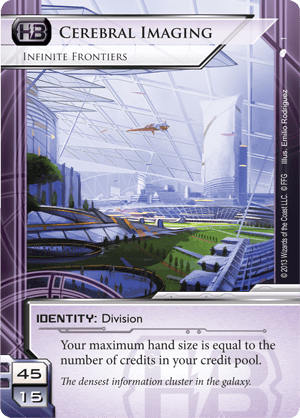
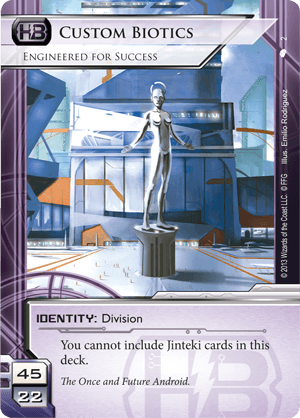
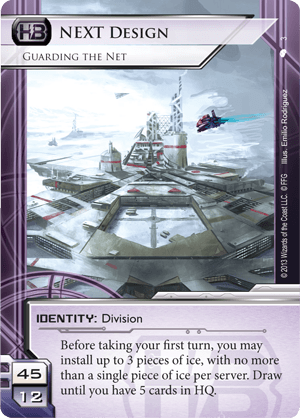
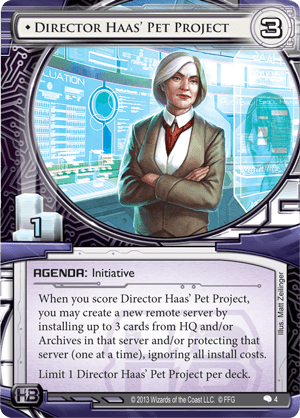
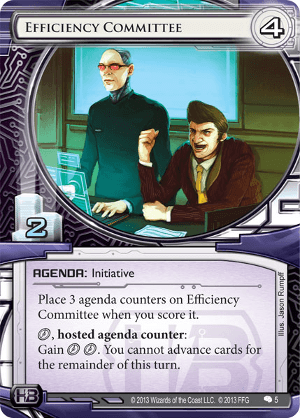
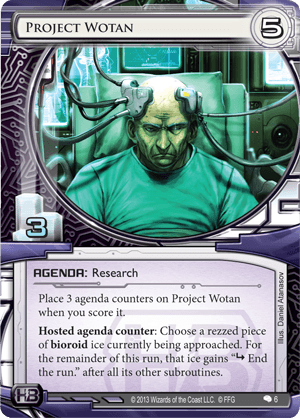
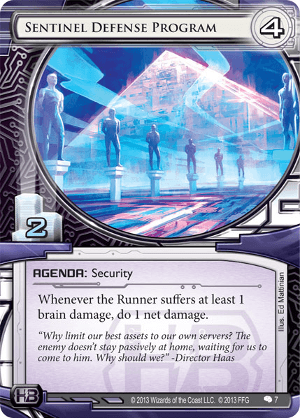
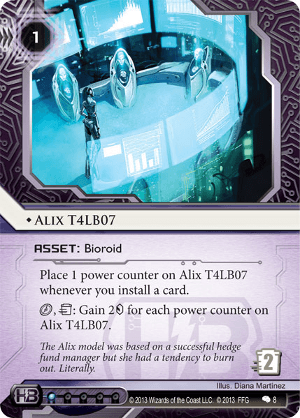
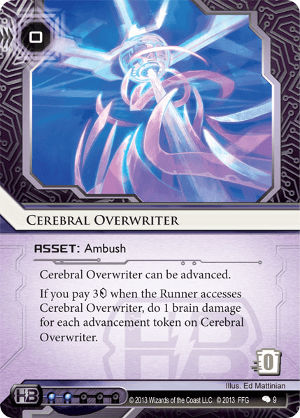
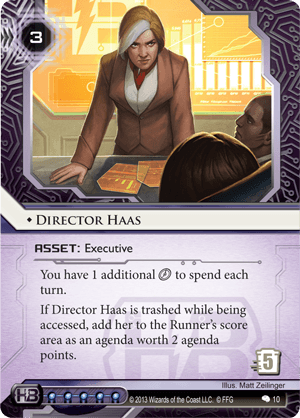

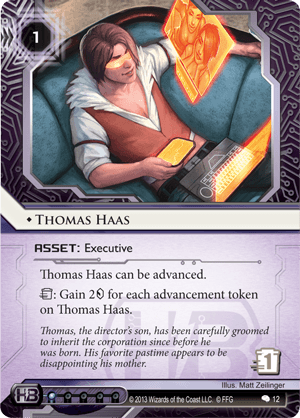
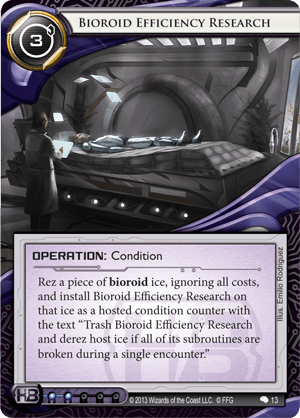
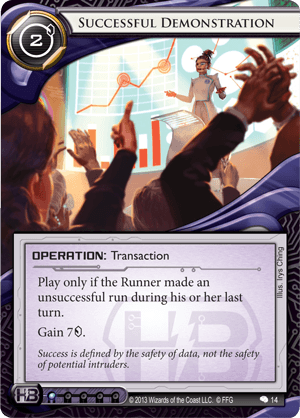
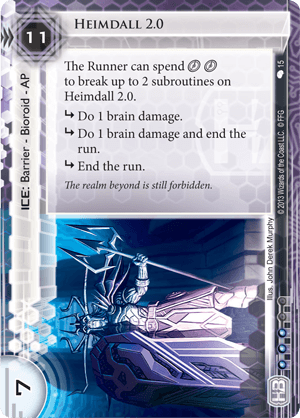
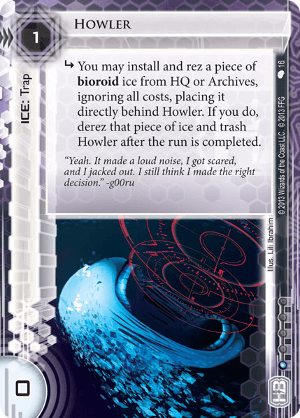
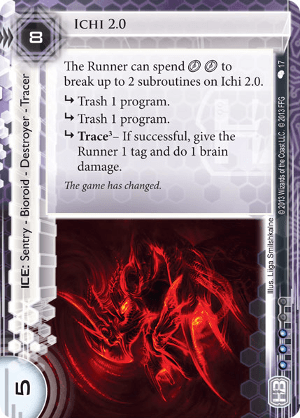
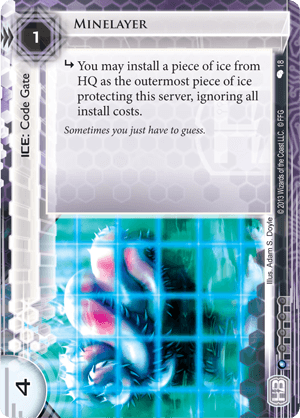
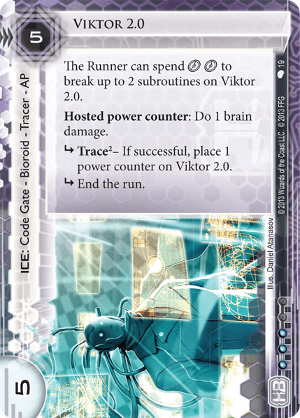
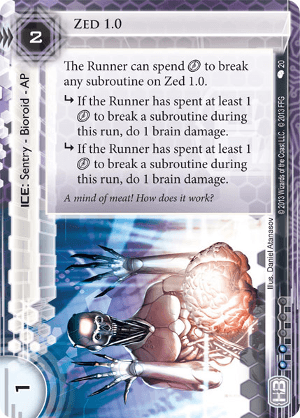
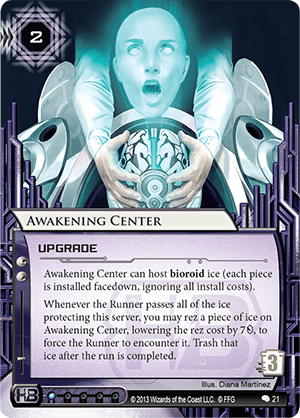
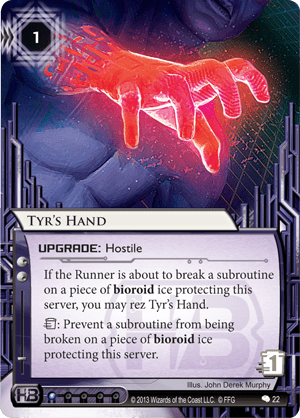
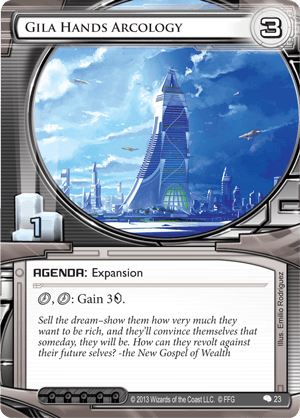
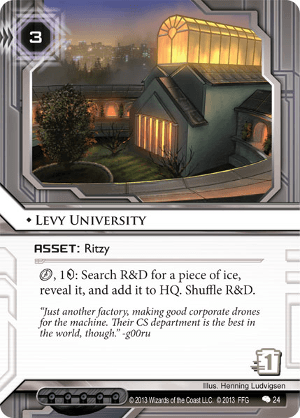
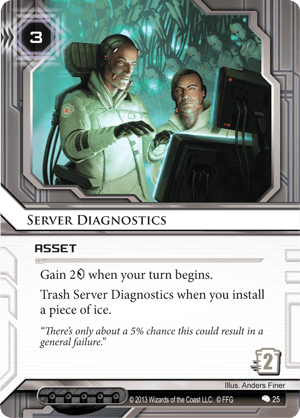
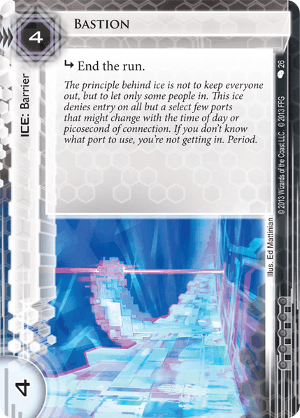
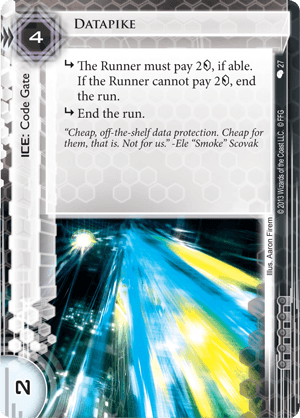
No comments:
Post a Comment